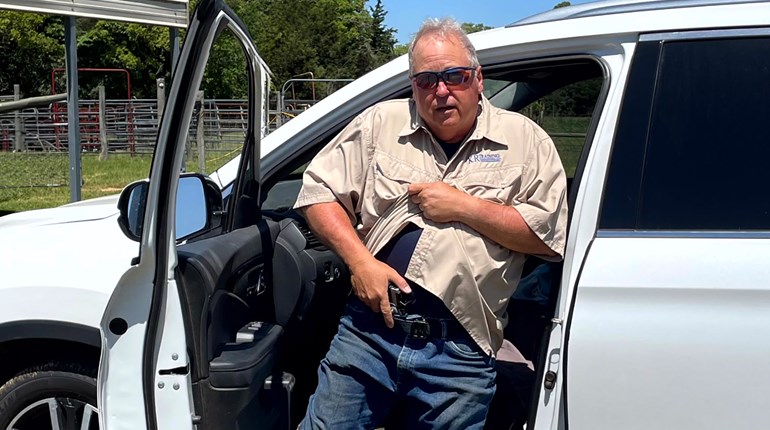
It’s a fact of life that we live a large part of our lives inside of our vehicles. From a daily commute to grocery runs to heading out for a night on the town, a vehicle of some sort is a part of our daily lives.
Which can be a problem, because road rage is a thing. Carjackings are a thing. And armed robberies in parking lots or gas stations is definitely a thing. Tom Givens, the noted firearms trainer and chief instructor at Rangemaster, says that for the armed citizen, there is no such thing as “street crime,” there is “parking lot crime.” The kinds of crime that worry the average armed citizen tends to happen in what are known as “transition spaces.” Those are the places where we transit from one location to another, such as going from a store to our car, or places where different elements of society rub up against each other, such as theaters, shopping malls and public parks.
There are plenty of firearm courses out there to help you deal with the threats outside of your home (the NRA, in fact, has a class dedicated to just this). The problem I’ve found is that most classes which teach protecting yourself in and around a vehicle tend to cater to law enforcement.
Which makes a lot of sense, because patrol officers pull over people in cars all the time, so knowing how to fight with a gun in and around a car is a useful skill for people who write a lot of traffic tickets. However, I don’t do traffic stops. I have to deal with navigating parking lots late at night, or deal with drivers who have a, ah, creative interpretation of the rules of the road.
This is where John Murphy’s Vehicle Encounter Skills and Tactics class comes in. John is the owner of FPF Training, and his two-day Street Encounter Skills class is one of the best classes out there for people who are new to the concealed carry lifestyle. The one day long Vehicle Encounter Skills class is similar, but deals with the reality of carrying concealed in and around a vehicle. You’ll note that I said “CARRYING concealed” and “in and AROUND” a vehicle. A gun inside of your car does you little good if you are attacked while filling up the tank of your vehicle, nor does it help you if you’re jumped in a parking lot. Take a lesson from law enforcement, and carry your sidearm with you, rather than leaving it in your car.

The class started off with a quick lesson on how to use pepper spray, and then moved on to how to manage unknown contacts, which are both useful skills for when people approach you as you’re outside of your vehicle. Other topics were learning how parked cars can be used as vision and movement barriers in your favor or how they can work against you, then we moved on to getting your gun into play as you are seated in your car.
Accessing a firearm on your waistband while wearing a seatbelt is fast and easy if you use the proper technique. For people who carry up front in an appendix holster, simply blouse your cover garment over the seat belt after you buckle up and then do your normal draw when you need your gun. For people who carry on the hip, it’s easy to hit the belt release with your support hand as you begin to clear your cover garment, and then continue your draw.

Then it was time to investigate how pistol bullets interact with a typical vehicle, and the results were fascinating. I found that when I fired my 9mm Tisas Stingray through the laminated glass of the front windshield, my rounds would head off in just about any direction instead of where I was aiming. This was because the plastic and glass sandwich of the windshield buckles and moves as the bullet hits it, changing the trajectory of the bullet in all sorts of interesting ways.

This is not true of the glass on the sides and rear of a vehicle, though. Rounds that hit that part of a car or truck will go right through with little change in where they are headed. However, the pillars on the sides of a car that hold the doors in place are made of steel folded in on itself over and over again, and as a result, (and somewhat to my surprise), they will stop a pistol round. Rifle rounds are another matter, but if you’re facing an attacker armed with a pistol, the steel of “B” pillar by the front door of your car is probably a safer place to be than huddling inside the car or hiding behind the trunk.
My biggest takeaway from this class was that dealing with lethal force when you’re around a vehicle requires unique skills, such as knowing how to draw while in your car or what your bullets do when it hits different parts of a vehicle. However, it also requires skills that you already know, such as keeping people at an appropriate distance from you and using the sights and trigger to get hits on target when they really matter. If you carry concealed on a regular basis, I urge you to take Murphy’s class or something similar that will help you apply your range skills to the open road.




































